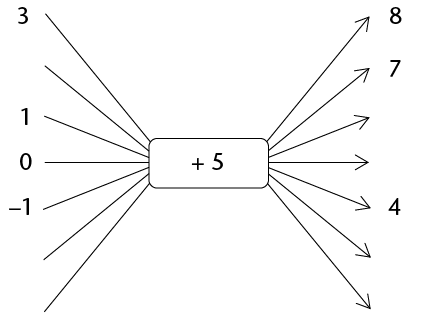5.6 Chapter summary
- An ordered pair is made of two numbers, and the independent value always comes first. The coordinate pair, \((x; y)\), is an example of an ordered pair.
- A table of values lists two groups of numbers:
- The top row lists the independent values (or input values or \(x\)-values).
- The bottom row lists the dependent values (or output values or \(y\)-values).
- The numbers that are above and below each other are related to each other by the equation, and make an ordered pair.
- The numbers that are above and below each other are related to each other by the equation.
- A relationship between two quantities can be shown using a flow diagram, such as the one below. Each input number in a flow diagram has a corresponding output number. The first (top) input number corresponds to the first output number. The second input number corresponds to the second output number, and so on.

- A completed flow diagram shows two kinds of information:
- It shows what calculations are done to produce the output numbers.
- It shows which output number is connected to which input number.
- A formula is a mathematical relationship or rule expressed in numbers and letters. A formula is also an equation, which shows how the amounts are related to each other.
- \(x\) is always the input value for an equation, and \(y\) is always the output value.
- Each pair of \(x\)- and \(y\)-values that correspond to each other and make the equation true is called a solution of the given equation. A solution to the equation is an ordered pair that fits into the equation. In other words, a solution is a combination of \(x\)- and \(y\)-values that makes one side of the equation equal to the other side.
